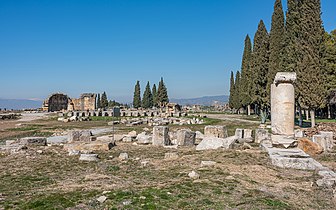Agora
This article needs additional citations for verification. (December 2021) |

The agora (
Origins
Early in Greek history (10th–4th centuries BC), free-born citizens would gather in the agora for military duty or to hear statements of the ruling king or council. Later, the agora also served as a
From these twin functions of the agora as a political and a commercial spot came the two Greek verbs ἀγοράζω, agorázō, "I shop", and ἀγορεύω, agoreúō, "I speak in public".[4]
Ancient Agora of Athens

The
Location and constituents

The agora was usually located in the middle of a city or near the harbor. Agoras were built of colonnades, or rows of long columns, and contained stoae, also known as a long open walkway below the colonnades.[7] They were beautifully decorated with fountains, trees, and statues. When the Athenian agora was rebuilt after the Greco-Persian Wars, colonnades and stoae were not incorporated.[8]
Phobia
The term agoraphobia denotes a phobic condition in which the sufferer becomes anxious in unfamiliar environments – for instance, places where they perceive that they have little control. Such anxiety may be triggered by wide-open spaces, crowds, or public situations, and the psychological term derives from the agora as a large and open gathering place.
Gallery
-
The Side State Agora in Side, Turkey
-
The Agora of Ephesus
-
Tlos Agora, southern Turkey
-
The Agora of the Competaliasts on Delos, Greece
-
Remains of theRoman period
-
The Agora of Hierapolis, Turkey
-
TheRoman Agora (Delphi), Greece
-
South agora and pool in Aphrodisias, Turkey
See also
References
- ^ Caves, R. W. (2004). Encyclopedia of the City. Routledge. p. 10.
- ISBN 978-1-884964-02-2.
- ISBN 0778720357. Retrieved 6 January 2017.
- Perseus Project.
- ^ "The Archaic Athenian Agora: Gateway to Classical Athenian Democracy". World History Encyclopedia. Retrieved 2020-12-01.
- ^ "The Athenian Agora". Atlas Obscura. Retrieved 2020-10-03.
- ^ "Stoa | architecture". Encyclopedia Britannica. Retrieved 2020-12-01.
- ^ "agora | Definition, History, & Facts". Encyclopedia Britannica. Retrieved 2020-12-01.
External links
 Media related to Agoras at Wikimedia Commons
Media related to Agoras at Wikimedia Commons- Official Athenian agora excavations
- Agora in Athens: photos








